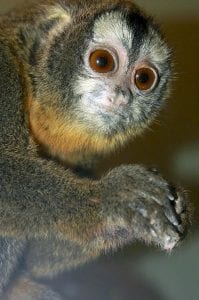Specimen of the week 325: The three-striped night monkey skull.
By ucwehlc, on 12 January 2018
In life this week’s specimen was small, loud and fluffy. It is also an unsung hero of science described by another unsung hero of science. This specimen of the week is…
**The three-striped night monkey skull**
Eyebrows on fleek
Three-striped night monkeys have huge eyes, giving them excellent night vision, and are known for their loud calls. They have a distinctive facial pattern with prominent eyebrows which makes them look rather like startled Ewoks. They eat fruit, nuts, flowers, leaves, eggs and insects, and are found in Venezuela and Brazil. This species is also known as the douroucouli, owl monkey, northern night monkey or Humboldt’s night monkey, but more on that later.
Night monkeys in science
The three-striped night monkey is not considered to be under threat by the IUCN (International Union for Conservation of Nature). However, related species of night monkey such as Aotus nancymaae are threatened by habitat loss and illegal trade for lab animals and pets, making them vulnerable to extinction. Night monkeys are particularly useful in malaria research as they are one of the few other primates that can be affected by the malaria parasite Plasmodium falciparum, and as such are highly sought-after. In the past this has led to them being taken from the wild in large numbers. In recent years various species of captive-bred night monkeys have been used in research into malaria-induced anaemia and potential malaria vaccines. Thank you night monkeys!

Three-sriped night monkey (Aotus trivirgatus) taxidermy from Smithsonian National Museum of Natural History, by David Stang, CC SA 4.0 licence
It was originally believed that there were only one or two species of night monkey, but a series of studies since the 1980s has uncovered a complex picture with up to 18 different potential species based on the number of chromosomes they have. Currently 11 different species are recognised by scientists, but this could well increase in the future.
Humboldt
In 1811 Aotus trivirgatus was the first night monkey described by a European scientist. It was named by Alexander von Humboldt, a pioneering German biologist and explorer. Humboldt was one of the first scientists to travel through South America, and is considered to be the father of the science of ecology, although he is nowhere near as famous today as he was in the 19th century. As well as being one of Darwin’s favourite authors and falling out with Napoleon over who had sold more books, Humboldt was also the first person to describe man-made climate change as early as 1800. He is said to be the person with the most species and places named after them, including at least four universities, several mountains, a penguin, and a really big squid.
Hannah Cornish is the Curatorial Assistant at the Grant Museum of Zoology
References
http://www.iucnredlist.org/details/summary/41543/0
http://www.iucnredlist.org/details/41540/0
https://www.nature.com/articles/s41541-017-0015-7
https://www.ncbi.nlm.nih.gov/pubmed/11986251
The Invention of Nature: The Adventures of Alexander von Humboldt, the Lost Hero of Science Andrea Wulf, 2016
 Close
Close



